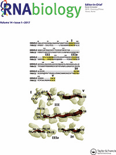
Transcription-Austin
Scope & Guideline
Catalyzing Discoveries in Genetics and Beyond
Introduction
Aims and Scopes
- Mechanisms of Transcription Regulation:
The journal explores the fundamental mechanisms by which transcription factors and other regulatory proteins influence gene expression, including studies on transcription factor dynamics, chromatin modifications, and RNA polymerase behavior. - Single-Cell Transcriptomics:
A significant focus is placed on single-cell RNA sequencing and transcriptomics, providing insights into cellular diversity, gene expression variability, and the molecular basis of phenotypic heterogeneity at the single-cell level. - Interplay Between Transcription and Other Cellular Processes:
Research that investigates the relationship between transcription and other cellular processes, such as replication, splicing, and translation, is a core area, highlighting the interconnected nature of gene expression. - Transcription in Pathology:
The journal features studies that address the role of transcriptional regulation in diseases, including cancer and immune disorders, emphasizing the potential for therapeutic interventions targeting transcriptional pathways. - Emerging Technologies in Transcription Research:
Transcription-Austin promotes the use of novel methodologies and technologies, such as single-molecule imaging and advanced sequencing techniques, to unravel complex transcriptional mechanisms and dynamics.
Trending and Emerging
- Dynamic and Contextual Transcriptional Regulation:
There is a growing emphasis on understanding transcription as a dynamic process influenced by various cellular contexts, including environmental factors and developmental stages, reflecting the complexity of gene regulation. - Single-Cell and Spatial Transcriptomics:
The rise of single-cell transcriptomics has led to a surge in publications focusing on cellular heterogeneity and spatial organization of gene expression, highlighting the importance of these approaches in modern transcription research. - Transcriptional Feedback and Oscillatory Systems:
Research exploring feedback mechanisms and oscillatory behavior in transcription factors, such as NF-κB, has gained traction, indicating a trend towards understanding the regulatory networks governing gene expression over time. - Transcriptional Regulation in Disease Contexts:
An increasing number of studies are exploring how transcriptional dysregulation contributes to various diseases, particularly cancer and immune disorders, indicating a shift towards translational research that bridges basic science and clinical applications. - Integration of Epigenetics and Transcription:
Emerging insights into the interplay between epigenetic modifications and transcriptional regulation are becoming a focal point, reflecting an integrated approach to understanding gene expression.
Declining or Waning
- Traditional Models of Transcription Regulation:
Research focusing on classical models of transcription regulation, which may have been predominant in earlier studies, seems to be less frequent, as the field shifts towards more complex and nuanced understandings of transcription mechanisms. - Basic Bacterial Transcription Studies:
While bacterial transcription remains a topic of interest, studies that merely describe basic transcription processes without integrating newer methodologies or insights into regulatory complexities are becoming less common. - Static Models of Gene Expression:
The exploration of static models that do not account for dynamic changes in transcriptional regulation over time appears to be declining, as researchers increasingly recognize the importance of temporal and spatial factors in gene expression.
Similar Journals

OMICS-A JOURNAL OF INTEGRATIVE BIOLOGY
Illuminating the pathways of integrative biological research.OMICS-A JOURNAL OF INTEGRATIVE BIOLOGY, published by Mary Ann Liebert, Inc., is a leading peer-reviewed journal dedicated to the field of integrative biology, encompassing Biochemistry, Biotechnology, Genetics, Molecular Biology, and Medicine. With an ISSN of 1536-2310 and E-ISSN of 1557-8100, this esteemed journal stands out with its commitment to advancing scientific knowledge and research within its scope, particularly effective from its inception in 2002 through to 2024. The journal holds a commendable position in various Scopus ranks, notably achieving a Q2 quartile in Biotechnology and Medicine (miscellaneous), and continues to exemplify rigorous scholarship with an impactful focus on cross-disciplinary integration. Although not an open-access publication, OMICS ensures that its readership has access to significant findings that shape contemporary biological discourse. Researchers, professionals, and students alike are encouraged to contribute to and explore this journal, as it not only advances knowledge but also fosters collaboration among diverse scientific communities.

BIOCHIMICA ET BIOPHYSICA ACTA-MOLECULAR CELL RESEARCH
Advancing the frontiers of cell and molecular biology.BIOCHIMICA ET BIOPHYSICA ACTA-MOLECULAR CELL RESEARCH is a premier journal published by Elsevier, dedicated to advancing the fields of cell biology and molecular biology. Established in 1982, this influential journal has been at the forefront of scientific research and innovation, currently holding esteemed positions with a Q2 ranking in Cell Biology and a Q1 ranking in Molecular Biology for 2023, reflecting its commitment to high-quality scholarship. With an impressive impact factor, it ranks in the 82nd and 78th percentiles for Molecular Biology and Cell Biology, respectively, amongst its peers. Researchers, professionals, and students will find this journal to be an invaluable resource for exploring the latest discoveries and methodologies in the molecular mechanisms underlying cellular functions. Although it is not an open-access journal, the insights offered in its pages contribute significantly to the scientific community's understanding of cellular and molecular processes, ensuring it remains a vital platform for disseminating cutting-edge research.

SEMINARS IN CELL & DEVELOPMENTAL BIOLOGY
Catalyzing Knowledge in Cell Biology and DevelopmentSEMINARS IN CELL & DEVELOPMENTAL BIOLOGY is a premier journal published by Academic Press Ltd - Elsevier Science Ltd, focusing on the vital domains of cell and developmental biology. With an impact factor that reflects its rigorous contributions to the field, this journal embodies the highest standards of academic excellence, currently ranking in the Q1 quartile for both Cell Biology and Developmental Biology categories as of 2023. Researchers and practitioners will appreciate its robust Scopus ranking, placing it within the top tiers of developmental biology and cell biology, with percentile ranks of 94th and 90th respectively, showcasing the journal's influential presence in the scientific community. The journal aims to disseminate comprehensive reviews, cutting-edge research articles, and significant advances in the understanding of cellular mechanisms and developmental processes, thereby catering to a diverse audience that includes researchers, scholars, and students dedicated to the life sciences. Given its commitment to open access, SEMINARS IN CELL & DEVELOPMENTAL BIOLOGY promotes widespread dissemination of knowledge, enhancing collaborative research efforts and driving innovation across biological disciplines.

EvoDevo, published by BMC, is a premier open-access journal dedicated to the fields of Developmental Biology, Ecology, Evolution, Behavior and Systematics, and Genetics. With an impressive Q1 ranking in its category for 2023, EvoDevo stands out as a significant resource for researchers, professionals, and students seeking to explore the intricate relationships between evolutionary processes and developmental mechanisms. Since its inception in 2010, this UK-based journal has provided a platform for innovative research and insights, boasting rigorous peer-review standards that ensure high-quality publications. With the E-ISSN of 2041-9139 and a commitment to freely accessible research, EvoDevo is positioned at the forefront of scientific discourse, making vital contributions to our understanding of biological complexities. As the journal converges years from 2010 to 2024, it serves as a cornerstone for knowledge dissemination, inspiring future research trajectories in evolutionary developmental biology.

TRENDS IN BIOCHEMICAL SCIENCES
Connecting Researchers with Cutting-Edge ScienceTRENDS IN BIOCHEMICAL SCIENCES is a premier academic journal published by CELL PRESS, focusing on the latest advancements and insights in the dynamic fields of biochemistry and molecular biology. With an ISSN of 0968-0004 and an E-ISSN of 1362-4326, this journal has established itself as a leading source of high-impact research, boasting an impressive Q1 category ranking in both Biochemistry and Molecular Biology as of 2023. The journal's Scopus Ranks further highlight its significance, placing it in the top 3% and 4% of its respective fields, emphasizing its role as a vital platform for disseminating innovative research. Published since 1976 and continuing through 2024, TRENDS IN BIOCHEMICAL SCIENCES provides a comprehensive overview of the latest trends, methods, and applications, helping researchers, professionals, and students stay at the forefront of their disciplines. Although it offers traditional access options, the journal's rich content and authoritative analysis make it a must-read for those pursuing cutting-edge biochemical research.

Genes & Genomics
Connecting Researchers with Cutting-Edge Genetic DiscoveriesGenes & Genomics is a prominent academic journal dedicated to the fields of biochemistry, genetics, and molecular biology, published by Springer from South Korea. With an evolving focus on innovative genetic research and its implications, this journal serves as a crucial platform for disseminating knowledge within the scientific community. The journal has been indexed in Scopus and boasts a Q3 quartile ranking in 2023 for its contributions to these disciplines, highlighting its relevance and growing impact. In addition to traditional subscription options, Genes & Genomics supports Open Access, offering broader accessibility for researchers and enthusiasts eager to explore the latest advancements in genetic studies. Since its inception in 2008, the journal has committed to publishing high-quality research that drives forward our understanding of genetics and its applications, making it an essential resource for researchers, professionals, and students alike who are passionate about the complexities and breakthroughs in genomic sciences.

MOLECULAR BIOLOGY
Fostering Innovation in Biochemistry and GeneticsMOLECULAR BIOLOGY, published by PLEIADES PUBLISHING INC, serves as a vital repository for the dissemination of innovative research within the fields of biochemistry, genetics, and molecular biology. With an ISSN of 0026-8933 and an E-ISSN of 1608-3245, this journal has been a mainstay in the scientific community since its inception, embracing its deep historical roots from 1971 to the present. Recognized for its qualitative contributions, MOLECULAR BIOLOGY is ranked in the Q3 quartile for Biophysics and Q4 for Structural Biology, placing it among select journals in its domain. Researchers and students alike benefit from its rigorous peer-reviewed articles, which focus on all aspects of molecular mechanisms and interactions. The journal's inclusion in prestigious databases underlines its commitment to academic excellence. The editorial board is dedicated to fostering the sharing of influential findings, making it an essential resource for advancing knowledge and innovation in molecular biology.

RNA Biology
Elevating RNA Studies to New HeightsRNA Biology is a premier journal published by Taylor & Francis Inc, focusing on the intricate and evolving field of RNA research. With an ISSN of 1547-6286 and E-ISSN of 1555-8584, this journal has established itself as an essential resource for professionals, researchers, and students engaged in both molecular and cell biology. Recognized in the 2023 quartile rankings, RNA Biology holds a distinguished Q1 category in Molecular Biology and a Q2 category in Cell Biology, indicative of its significant impact and reputation within the scientific community. The journal emphasizes the importance of RNA in various biological processes, highlighting both fundamental and applied aspects, which is crucial for advancing our understanding of gene expression and regulation. With a strong Scopus ranking, including Rank #105/410 in Molecular Biology and Rank #83/285 in Cell Biology, RNA Biology is not just a publication but a vital platform for sharing groundbreaking findings and insights into RNA research. With a convergence that spans from 2004 to 2024, the journal promises to continue its legacy of excellence in disseminating important discoveries in RNA science, contributing richly to ongoing scientific dialogue and innovation.

GENE EXPRESSION PATTERNS
Exploring the Depths of Developmental BiologyGENE EXPRESSION PATTERNS, published by Elsevier, is a peer-reviewed academic journal specializing in the field of developmental biology, genetics, and molecular biology. With the ISSN 1567-133X and E-ISSN 1872-7298, it has been a crucial platform for researchers since its inception in 2001. Although classified in the Q4 quartile across its relevant categories for 2023, the journal plays an essential role in disseminating innovative studies that shed light on intricate gene expression mechanisms. Located in Amsterdam, Netherlands, the journal aims to provide a comprehensive understanding of gene regulation through rich analyses and original studies, thus appealing to a wide audience, including esteemed researchers, dedicated professionals, and enthusiastic students in the biomedical arena. Access to this journal is not open, which underscores the necessity of institutional subscriptions for full articles, reinforcing its targeted dissemination of specialized knowledge in gene expression.

FEBS LETTERS
Igniting Passion for Molecular and Cellular ResearchFEBS LETTERS, published by Wiley, is a prestigious journal that has firmly established its place in the fields of biochemistry, biophysics, genetics, molecular biology, cell biology, and structural biology. With an esteemed history dating back to 1968, this journal continues to be a vital resource for researchers and professionals involved in the biological sciences. It boasts impressive quartile rankings, including Q1 statuses in several categories such as Biochemistry and Genetics, reflecting its high impact factor and significant contribution to scientific discourse. FEBS LETTERS provides a platform for innovative findings and critical reviews, fostering the exchange of knowledge and ideas within the scientific community. Although it operates under a subscription model, the journal ensures broad dissemination of groundbreaking research through its rigorous peer-review process. The vibrant discussions encouraged by articles published in FEBS LETTERS aim to inspire current and future generations of scientists to push the boundaries of biological understanding, making it an indispensable resource for anyone dedicated to advancing their knowledge in these dynamic fields.